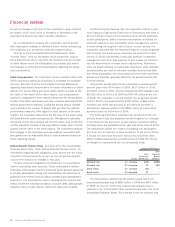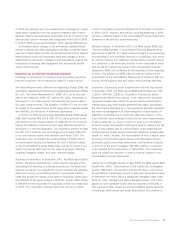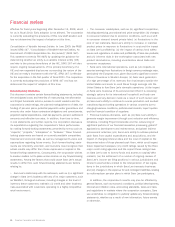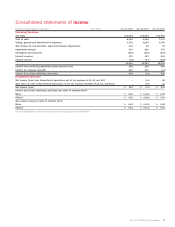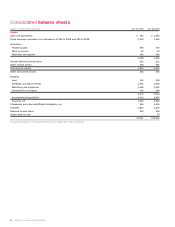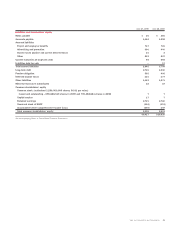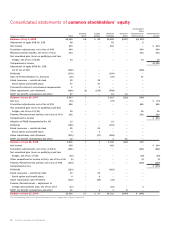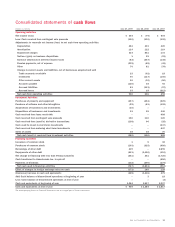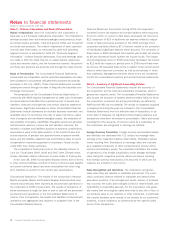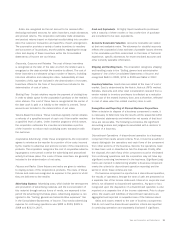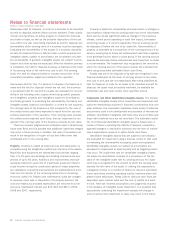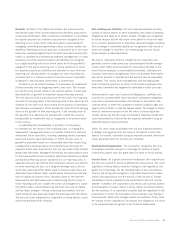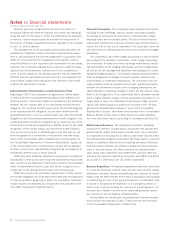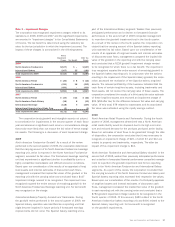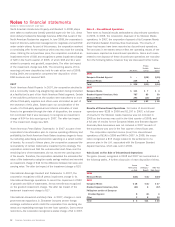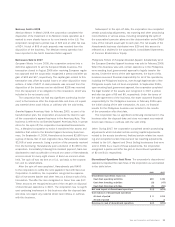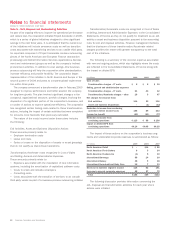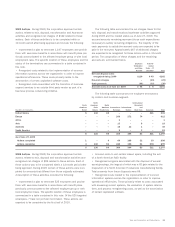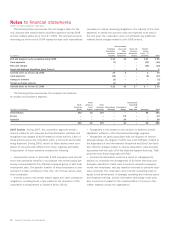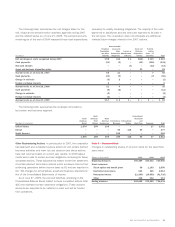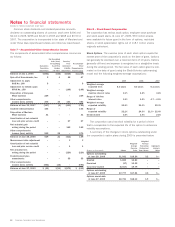Sara Lee 2009 Annual Report Download - page 56
Download and view the complete annual report
Please find page 56 of the 2009 Sara Lee annual report below. You can navigate through the pages in the report by either clicking on the pages listed below, or by using the keyword search tool below to find specific information within the annual report.Notes to financial statements
Dollars in millions except per share data
Businesses Held for Disposal
In order for a business to be classified
as held for disposal, several criteria must be achieved. These criteria
include, among others, an active program to market the business
and locate a buyer, as well as the probable disposition of the busi-
ness within one year. Upon being classified as held for disposal, the
recoverability of the carrying value of a business must be assessed.
Evaluating the recoverability of the assets of a business classified
as held for disposal follows a defined order in which property and
intangible assets subject to amortization are considered only after
the recoverability of goodwill, intangible assets not subject to amor-
tization and other assets are assessed. After the valuation process
is completed, the held for disposal business is reported at the lower
of its carrying value or fair value less cost to sell. The carrying
value of a held for disposal business includes the portion of the
cumulative translation adjustment related to the operation.
Businesses Held for Use
If a decision to dispose of a business is
made and the held for disposal criteria are not met, the business
is considered held for use and its assets are evaluated for recover-
ability in the following order: assets other than goodwill, property
and intangibles; property and intangibles subject to amortization;
and finally, goodwill. In evaluating the recoverability of property and
intangible assets subject to amortization, in a held for use business,
the carrying value of the business is first compared to the sum of
the undiscounted cash flows expected to result from the use and
eventual disposition of the operation. If the carrying value exceeds
the undiscounted expected cash flows, then an impairment is rec-
ognized if the carrying value of the business exceeds its fair value.
There are inherent judgments and estimates used in determining
future cash flows and it is possible that additional impairment charges
may occur in future periods. In addition, the sale of a business can
result in the recognition of a gain or loss that differs from that
anticipated prior to the closing date.
Property Property is stated at historical cost and depreciation is
computed using the straight-line method over the lives of the assets.
Machinery and equipment are depreciated over periods ranging
from 3 to 25 years and buildings and building improvements over
periods of up to 40 years. Additions and improvements that sub-
stantially extend the useful life of a particular asset and interest
costs incurred during the construction period of major properties
are capitalized. Leasehold improvements are capitalized and amor-
tized over the shorter of the remaining lease term or remaining
economic useful life. Repairs and maintenance costs are charged
to expense. Upon sale or disposition of a property element, the
cost and related accumulated depreciation are removed from the
accounts. Capitalized interest was $10, $18 and $20 in 2009,
2008 and 2007, respectively.
Property is tested for recoverability whenever events or changes in
circumstances indicate that its carrying value may not be recoverable.
Such events include significant adverse changes in the business
climate, current period operating or cash flow losses, forecasted
continuing losses or a current expectation that an asset group will
be disposed of before the end of its useful life. Recoverability of
property is evaluated by a comparison of the carrying amount of an
asset or asset group to future net undiscounted cash flows expected
to be generated by the asset or asset group. If the carrying amount
exceeds the estimated future undiscounted cash flows then an asset
is not recoverable. The impairment loss recognized is the amount by
which the carrying amount of the asset exceeds the estimated fair
value using discounted estimated future cash flows.
Assets that are to be disposed of by sale are recognized in the
financial statements at the lower of carrying amount or fair value,
less cost to sell, and are not depreciated after being classified as
held for disposal. In order for an asset to be classified as held for
disposal, the asset must be actively marketed, be available for
immediate sale and meet certain other specified criteria.
Trademarks and Other Identifiable Intangible Assets The primary
identifiable intangible assets of the corporation are trademarks and
customer relationships acquired in business combinations and com-
puter software. The corporation capitalizes direct costs of materials
and services used in the development and purchase of internal-use
software. Identifiable intangibles with finite lives are amortized and
those with indefinite lives are not amortized. The estimated useful
life of a finite-lived identifiable intangible asset is based upon a
number of factors, including the effects of demand, competition,
expected changes in distribution channels and the level of mainte-
nance expenditures required to obtain future cash flows.
Identifiable intangible assets that are subject to amortization
are evaluated for impairment using a process similar to that used
in evaluating the recoverability of property, plant and equipment.
Identifiable intangible assets not subject to amortization are
assessed for impairment at least annually and as triggering events
may occur. The impairment test for identifiable intangible assets
not subject to amortization consists of a comparison of the fair
value of the intangible asset with its carrying amount. An impair-
ment loss is recognized for the amount by which the carrying value
exceeds the fair value of the asset. In making this assessment,
management relies on a number of factors to discount estimated
future cash flows including operating results, business plans and
present value techniques. Rates used to discount cash flows are
dependent upon interest rates and the cost of capital at a point
in time. There are inherent assumptions and judgments required
in the analysis of intangible asset impairment. It is possible that
assumptions underlying the impairment analysis will change in
such a manner that impairment in value may occur in the future.
54 Sara Lee Corporation and Subsidiaries


